This Sourdough Discard Pizza Dough has a distinctively tangy flavor with an airy, open crumb and satisfyingly crispy texture. Made with no yeast and nearly two cups of unfed starter, this sourdough pizza crust is ready the same day and requires no kneading.
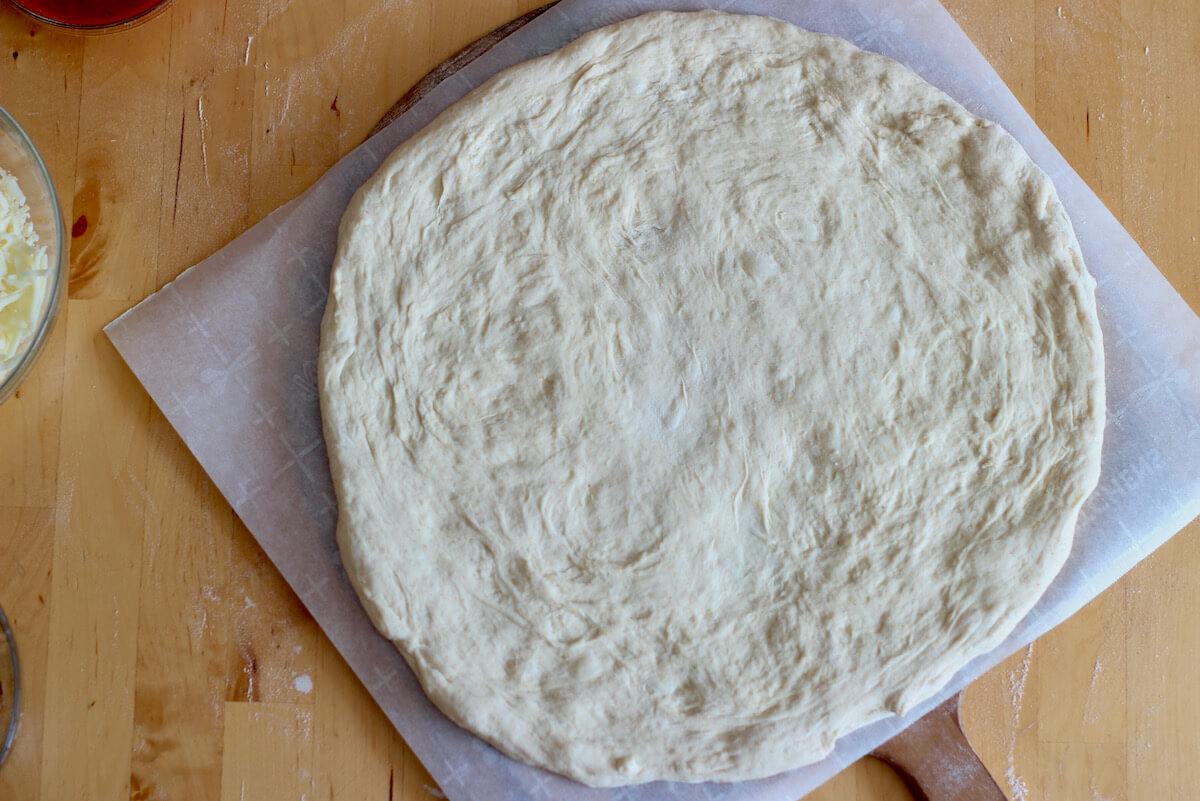
Homemade pizza is one of my favorite things to make. We have it for dinner at my house at least once a month, if not more often. So, when I started experimenting with sourdough, one of the first recipes I mastered was this sourdough discard pizza dough.
Sourdough discard refers to the portion of sourdough starter that is removed and discarded before feeding. However, despite its name, it is edible and incredibly delicious in all kinds of recipes.
My version of sourdough pizza dough contains nearly two cups of discard for a flavorful crust that ferments quickly and is ready the same day. It’s a great way to use up a lot of discarded starter at once and prevent food waste.
Today, I’m walking you through how to make no yeast sourdough discard pizza dough, including which ingredients to use, tips for success, and some ideas for topping and cooking your homemade sourdough pizza.
Disclaimer: Some links throughout this post are affiliate links. As an Amazon Associate, I earn from qualifying purchases. You can learn more by visiting my Affiliate Disclosure Page.
Why You'll Love This Recipe
- No Yeast- This quick sourdough pizza dough rises naturally using no added yeast.
- Made with Sourdough Discard- Nearly two cups of sourdough starter discard go into this easy sourdough discard recipe.
- Same Day- You can have sourdough pizza ready for dinner tonight with this same day sourdough pizza crust recipe.
- No Knead- This recipe uses a process called "stretching and folding" to build gluten in this no knead sourdough pizza dough.
- Only 4 Ingredients- With just four ingredients - discard, flour, water, and salt - this recipe relies on basic pantry staples that you likely already have on hand.
Tips for Success
- Measure ingredients by weight. For the most accurate and consistent results, measure your ingredients by weight using a food scale. If using measuring cups for flour, spoon it into the cup rather than scooping it from the container.
- Use the windowpane test. After 4 sets of stretch and folds, check gluten development by gently stretching a small piece of dough thinly enough to see your fingers through it.
- Find a warm place in your kitchen. Yeast thrives in warmth (around 80°F). If your kitchen is cool, place the dough in the oven with the light on during bulk fermentation.
- Stretch by hand. Avoid using a rolling pin. Instead, gently stretch the dough by hand to preserve air bubbles.
- Use enough flour while stretching. To prevent the dough from sticking to your hands or the work surface while stretching, dust lightly with flour as needed. This will make it easier to handle and shape the dough without tearing or sticking.
- Bake your pizza as soon as you've finished assembling it. Letting the toppings sit for too long will result in soggy pizza dough.
Ingredient Notes
Here are some notes on key ingredients. For a full list of ingredients, check out the recipe card below.
- Sourdough Discard- I keep my discard in a separate container in my refrigerator so I can make sourdough discard recipes whenever I want. You can also use active sourdough starter in this recipe. Need help getting started with sourdough? Check out my guide on how to make sourdough starter from scratch.
- Bread Flour- Bread flour is ideal for pizza crust because of its higher protein content, which helps develop gluten and create a chewy texture. All-purpose flour can be used as a substitute, but the crust may be slightly less chewy. If using whole wheat flour to replace some of the white flour, you will need to add extra water to maintain the same dough consistency.
- Water- Use warm water (around 80-90°F) to encourage yeast activity. For beginners, note that this higher hydration dough can be sticky and challenging to handle. To make it more manageable, consider reducing the water amount to 250 grams.
- Kosher Salt- Salt enhances the flavor of the pizza dough. I recommend using kosher salt, as table salt often contains anti-caking agents. If using table salt, measure by weight or use half the amount.
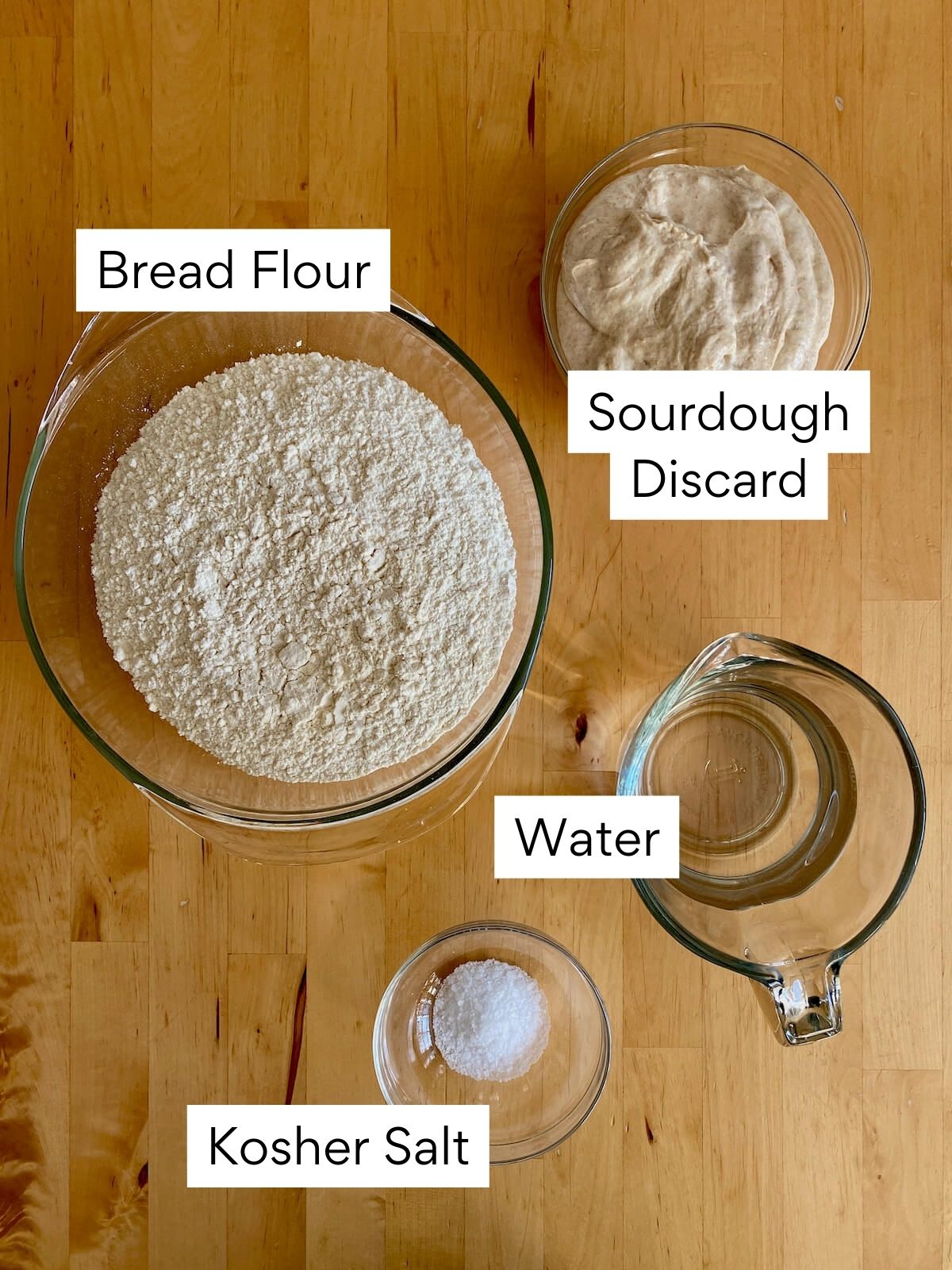
Equipment Notes
Here are some notes on any special equipment I used to make this recipe.
- Using a kitchen scale to measure ingredients by weight ensures accuracy and consistency in your dough.
- A bench scraper is useful for dividing the dough, shaping it into balls, and transferring it to the baking surface. It's also handy for scraping dough off the work surface and keeping things tidy.
- Parchment paper is helpful for transferring the stretched pizza dough to the oven and prevents sticking.
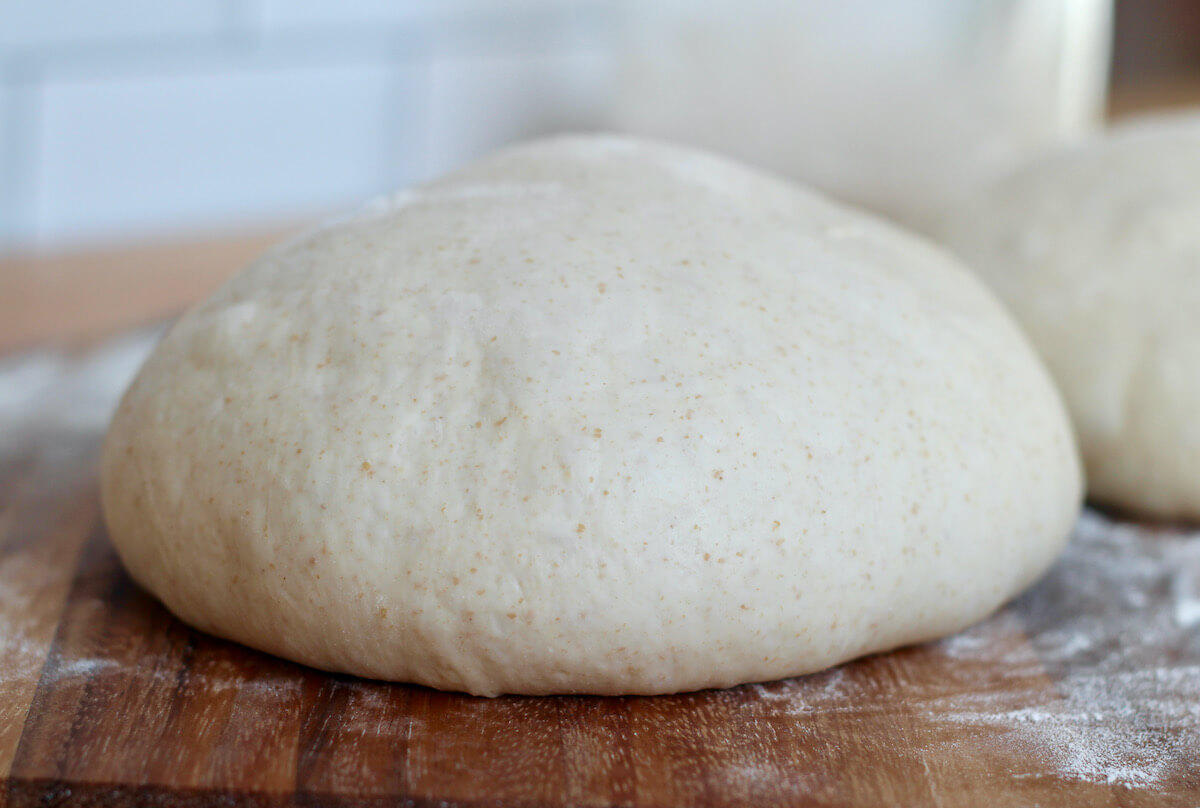
How to Make Sourdough Discard Pizza Dough
Here is how to make sourdough pizza dough using sourdough discard.
Mix the Dough
- In a large mixing bowl, combine the bread flour, warm water, sourdough starter discard, and kosher salt.
- Mix everything together until no dry flour remains and a cohesive dough forms.
- Cover the bowl and let the dough rest for 20 minutes.
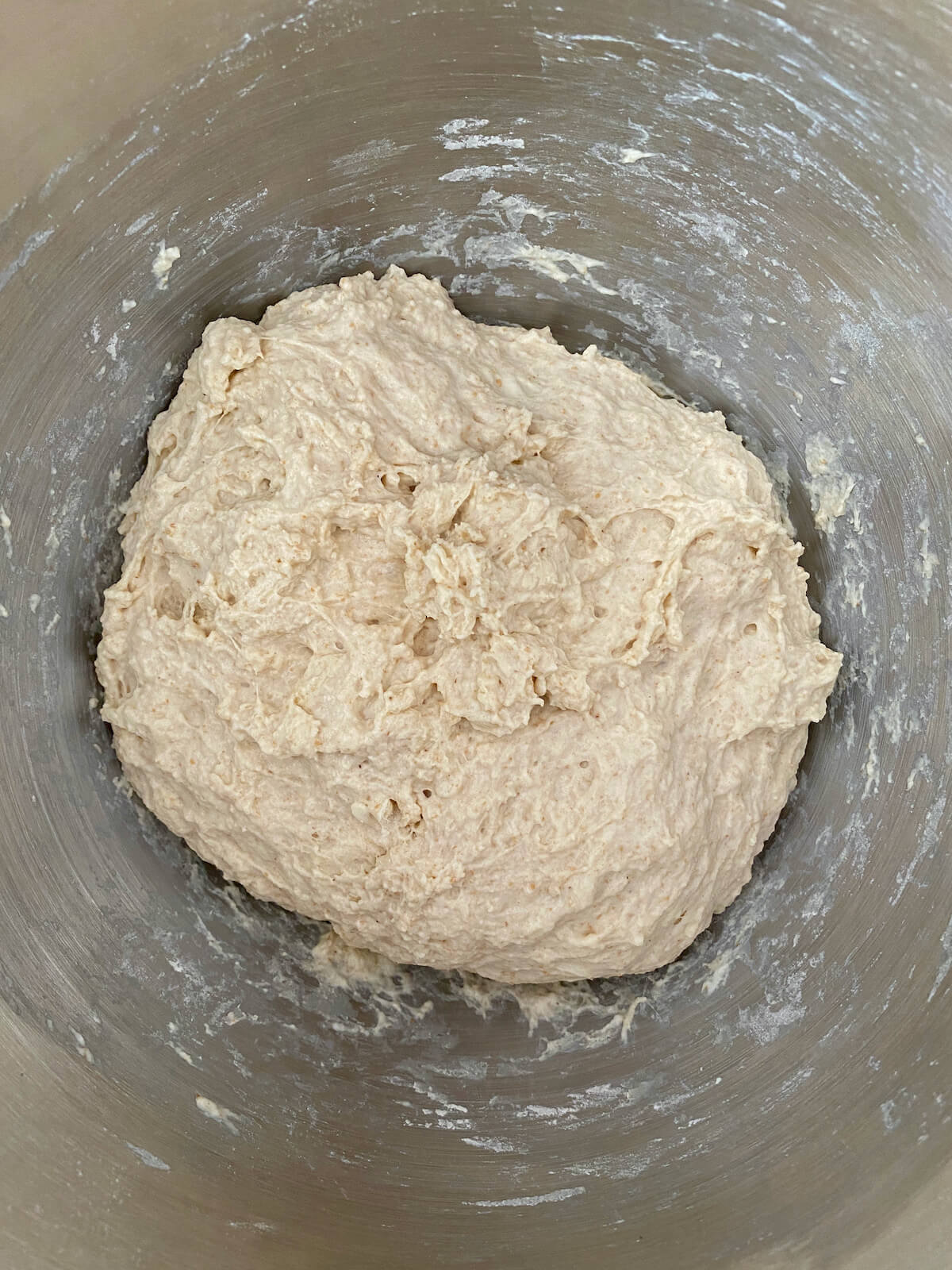
Stretch and Fold
- After 20 minutes, lightly wet your hands with water.
- Gently stretch one edge of the dough up and fold it over onto itself. Rotate the bowl 90 degrees and repeat, stretching and folding the dough a total of four times.
- After the fourth fold, flip the dough over so that the seam side is facing down.
- Cover the bowl again and let the dough rest for 15 minutes.
- Repeat the stretching and folding process for a total of 4-6 sets or until the dough appears smooth and feels elastic.
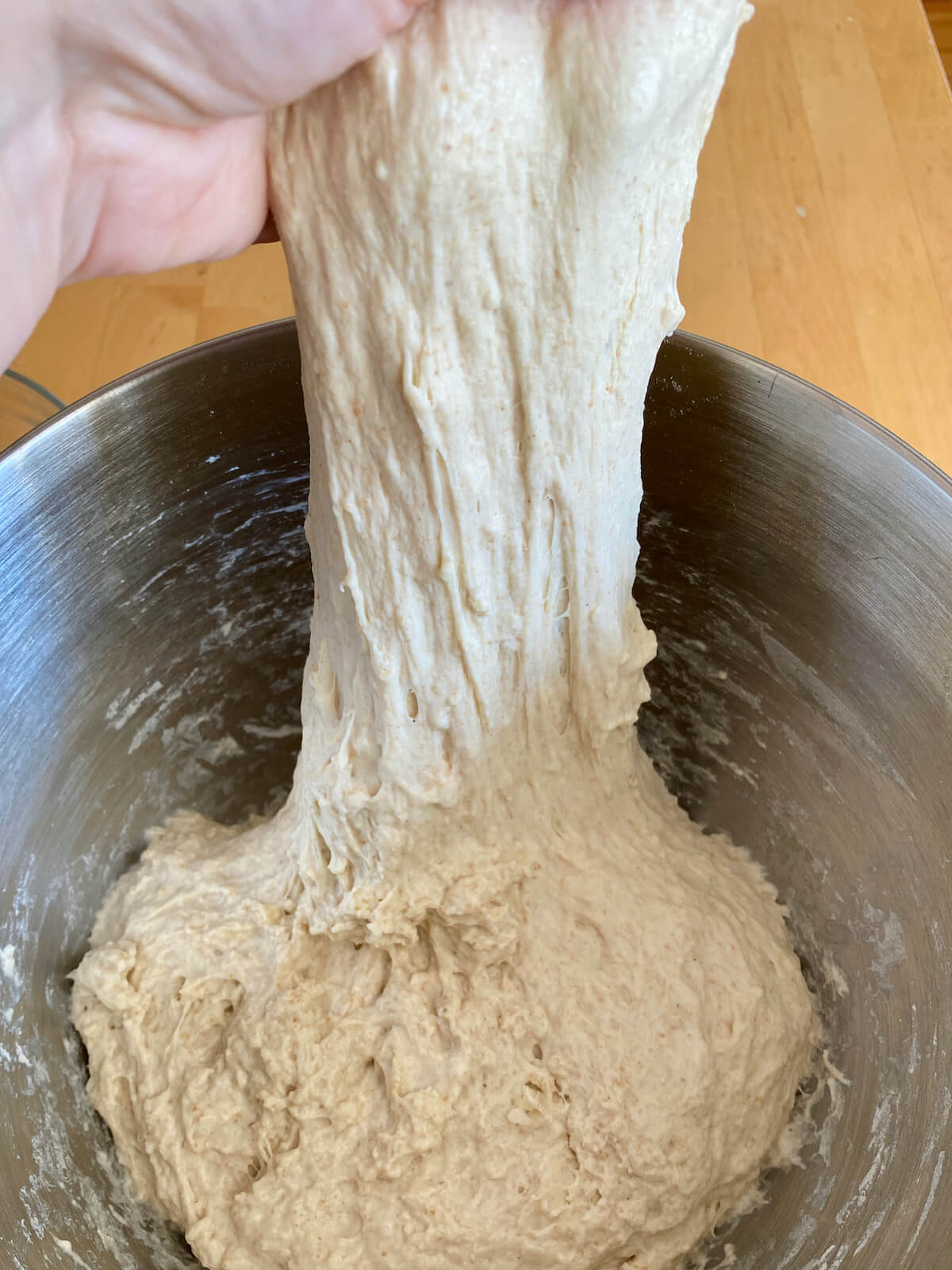
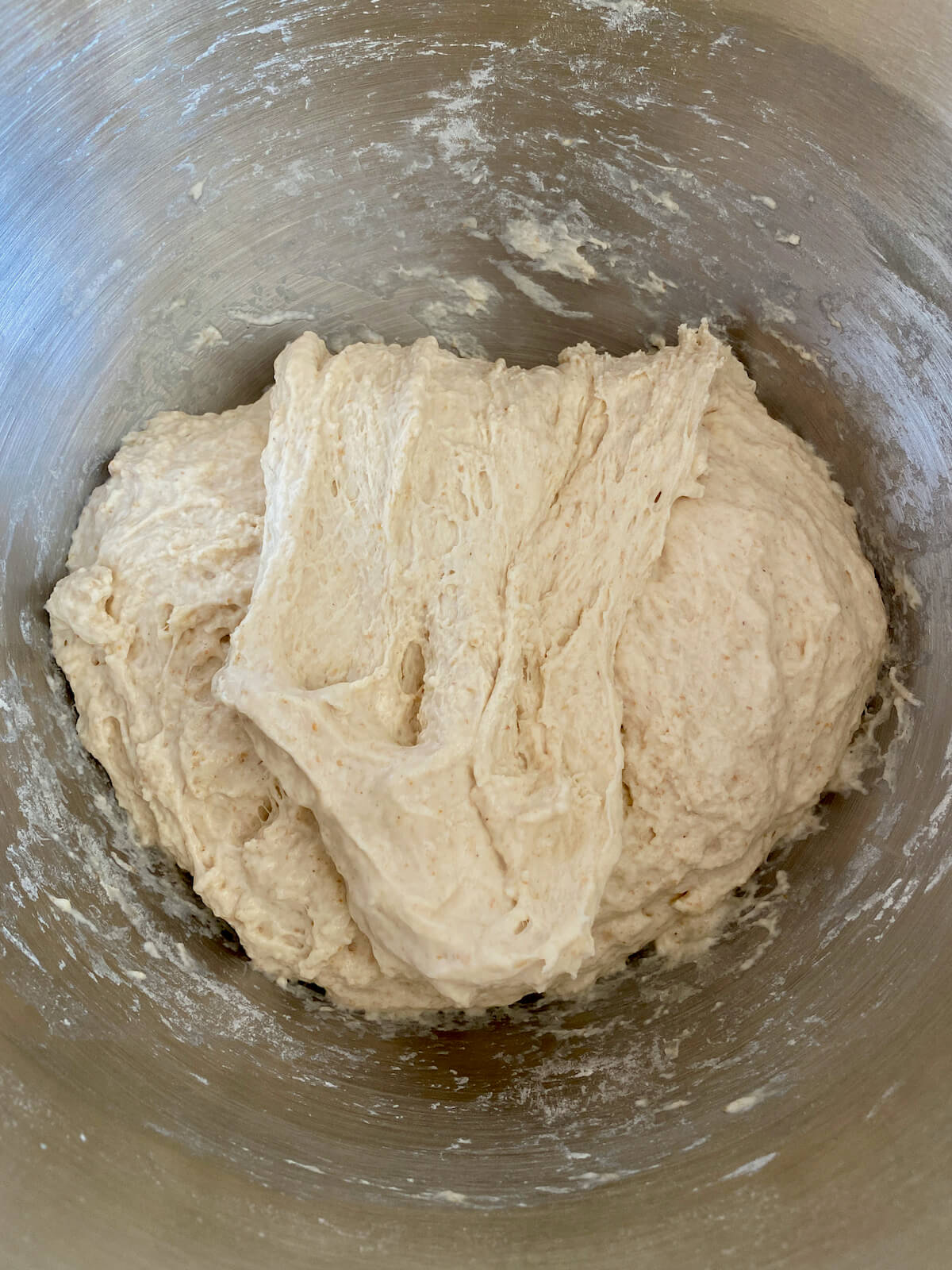
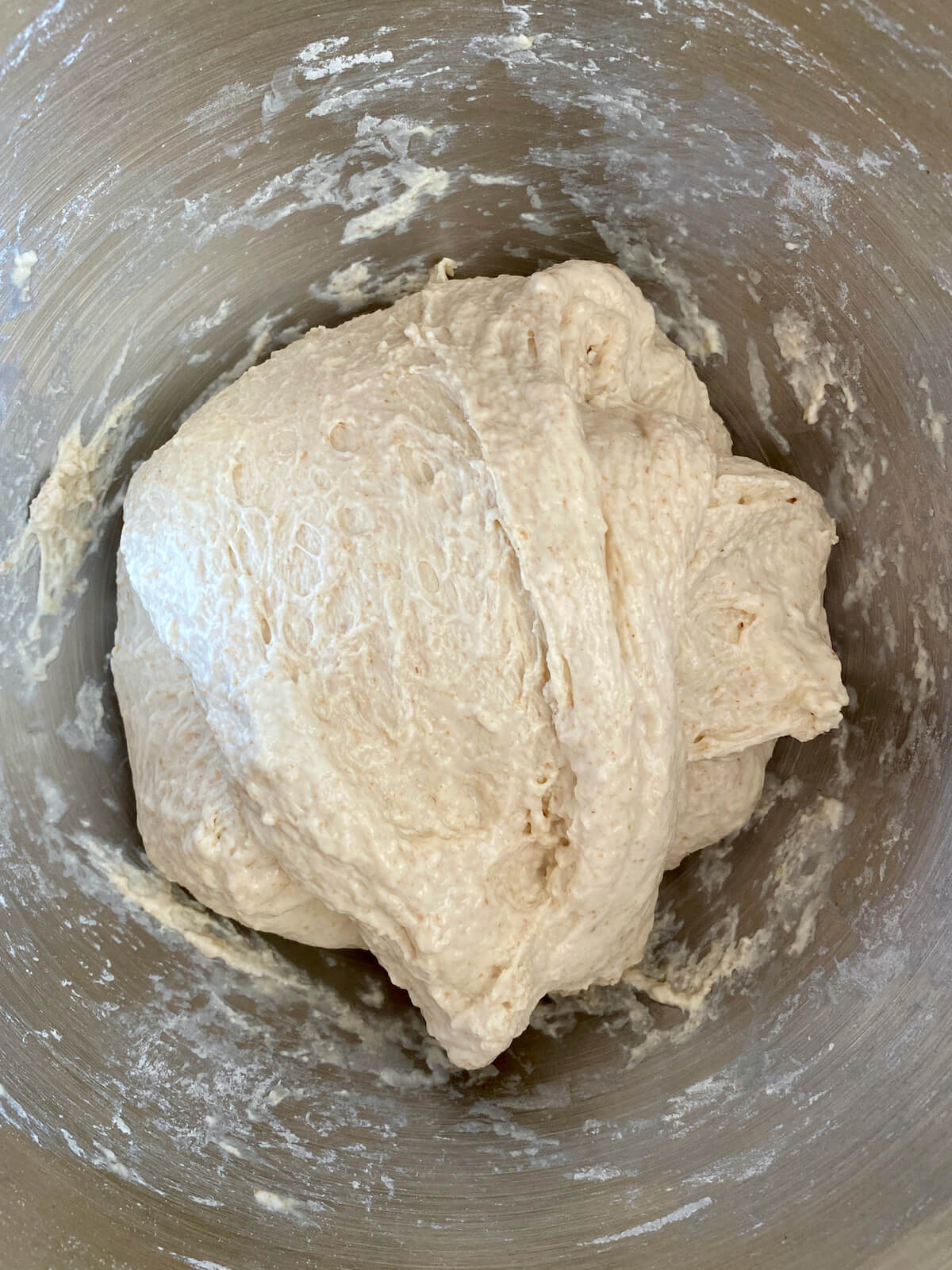
Bulk Fermentation
- Cover the dough and allow it to rise in a warm environment (75°F) for about 2 hours.
- Note that it may take more or less time to rise depending on factors such as the warmth of your kitchen, the activity level of your sourdough starter, and the age of your discard.
- The dough should double in size and have noticeable gas bubbles forming on the surface.
- If your kitchen is cooler, consider placing the covered bowl inside an off oven with just the light on to provide gentle warmth.
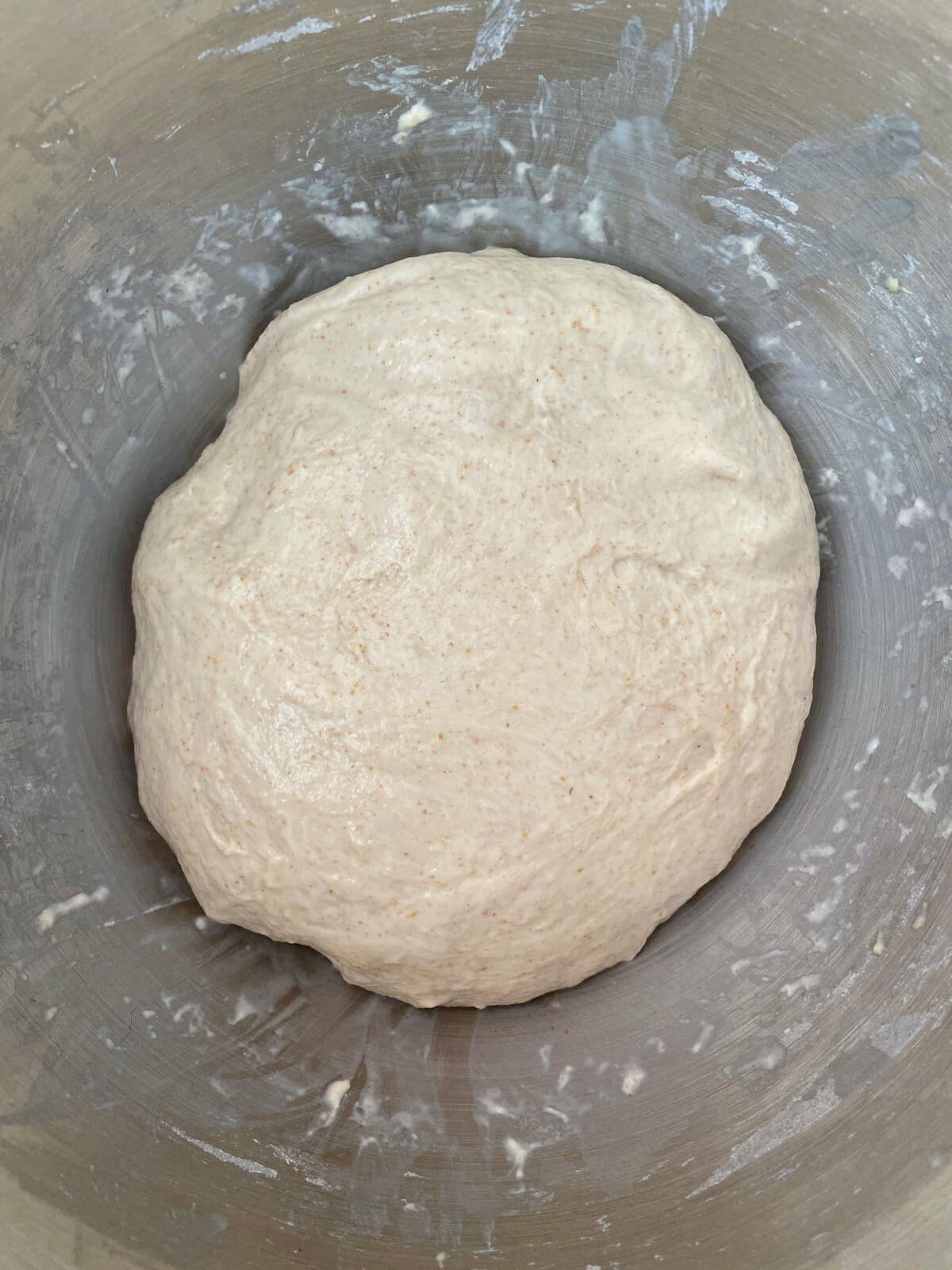
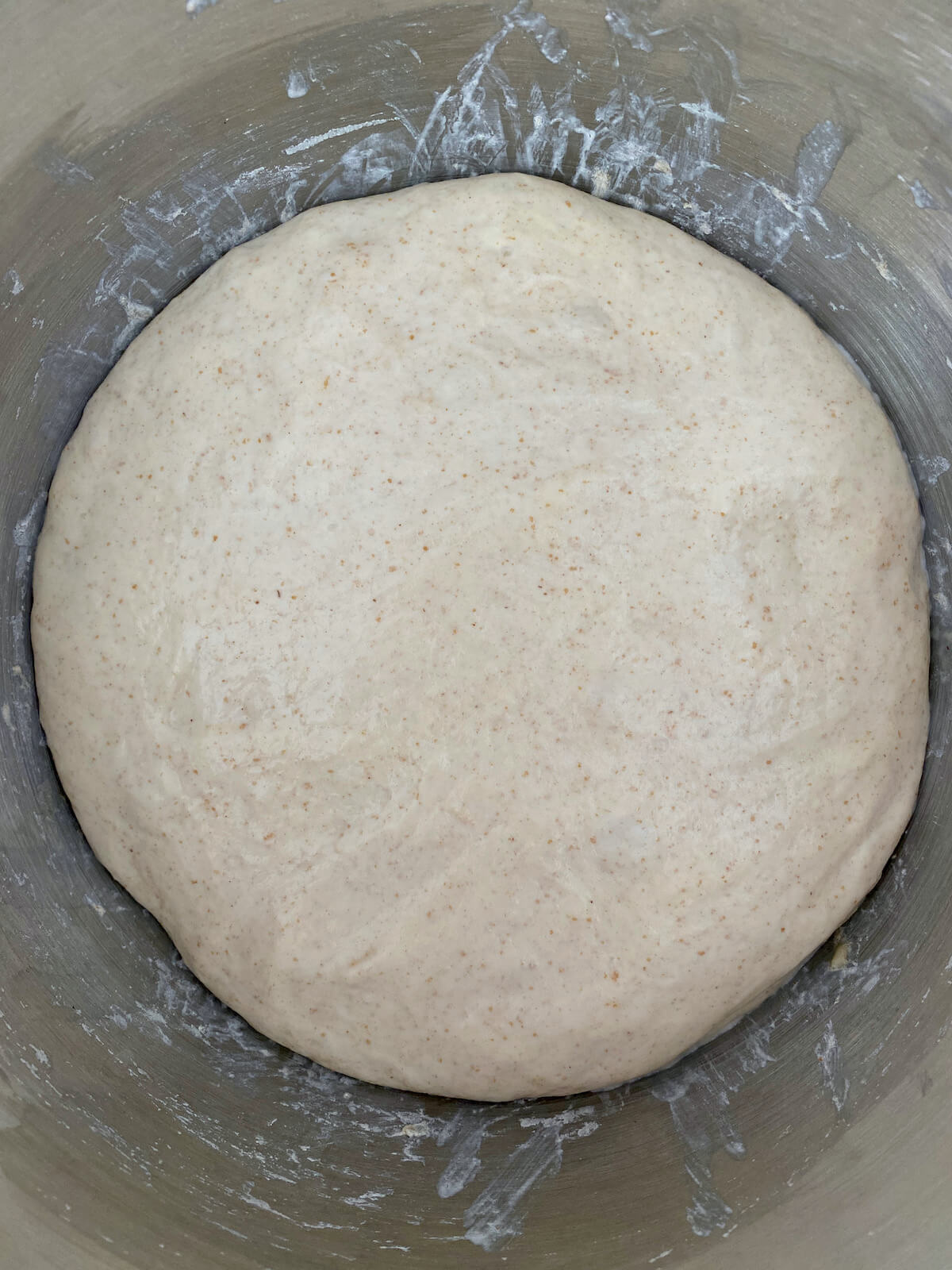
Shape
- Carefully turn the dough out onto a lightly floured work surface.
- Using a bench scraper, divide the dough into 2 equal pieces.
- Shape each piece by gently pulling the dough into a rough rectangle.
- Then, fold the top edge of the rectangle down towards the center, pressing lightly to seal. Repeat this process with the bottom edge, folding it up towards the center and pressing lightly to seal.
- Next, fold the left and right sides of the rectangle towards the center, overlapping slightly, and press lightly to seal.
- Finally, flip the dough over so that the seam side is facing down, and use your hands to gently shape it into a smooth, round ball.
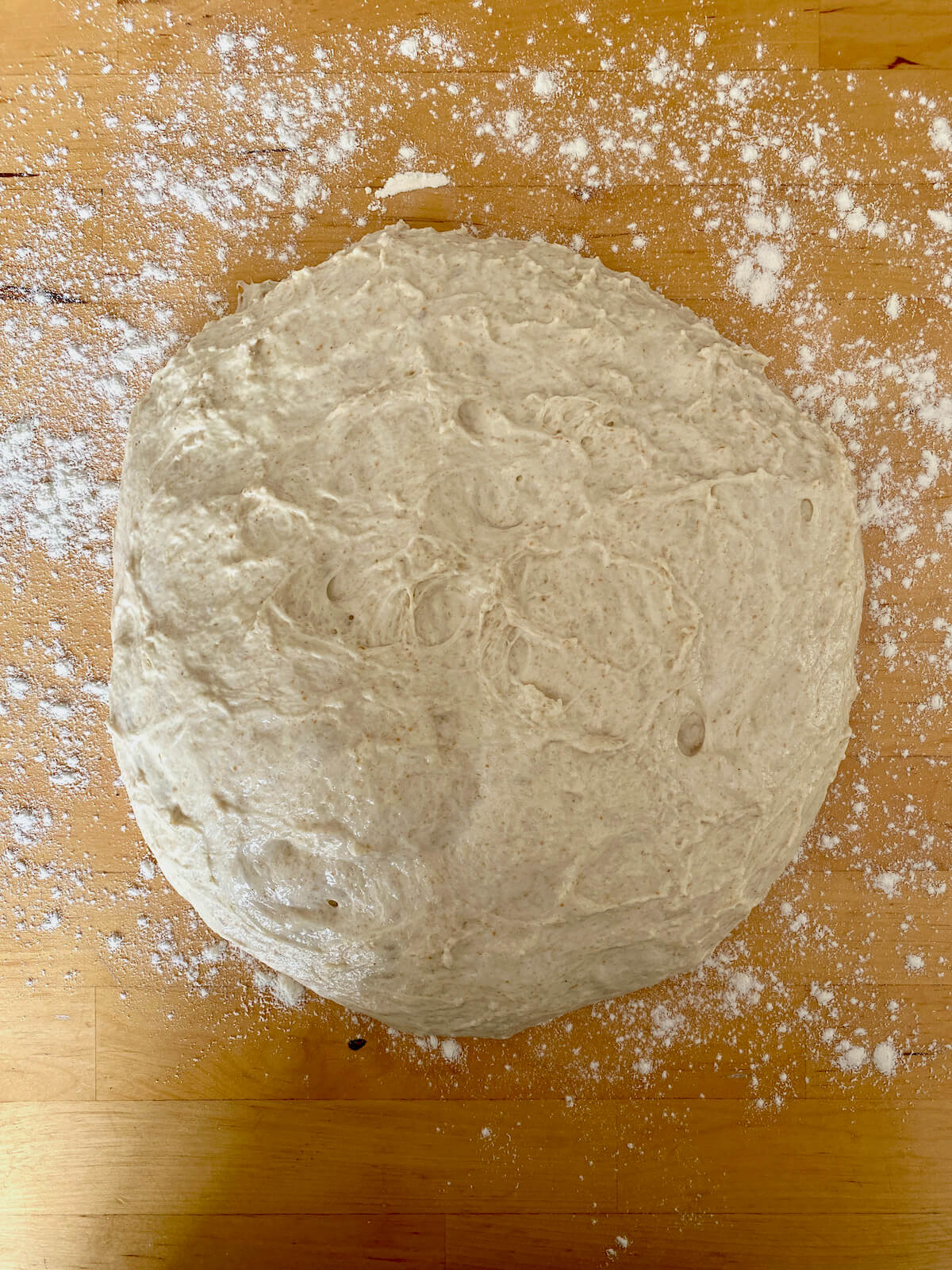
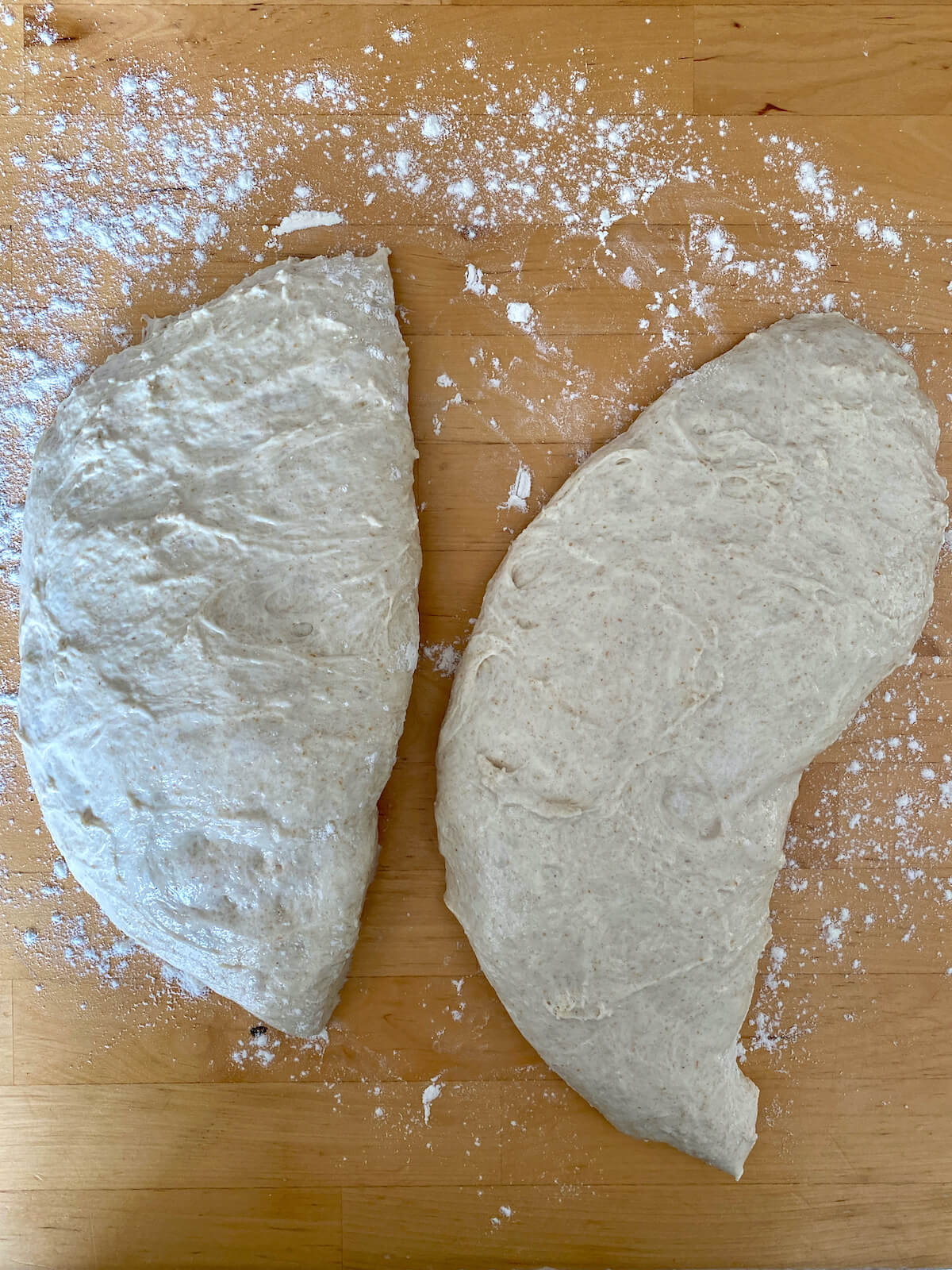

Proof
- Place the dough balls on a lightly floured surface or parchment paper and cover them with plastic wrap.
- Let them rest at room temperature for 15-20 minutes before using them for pizza.
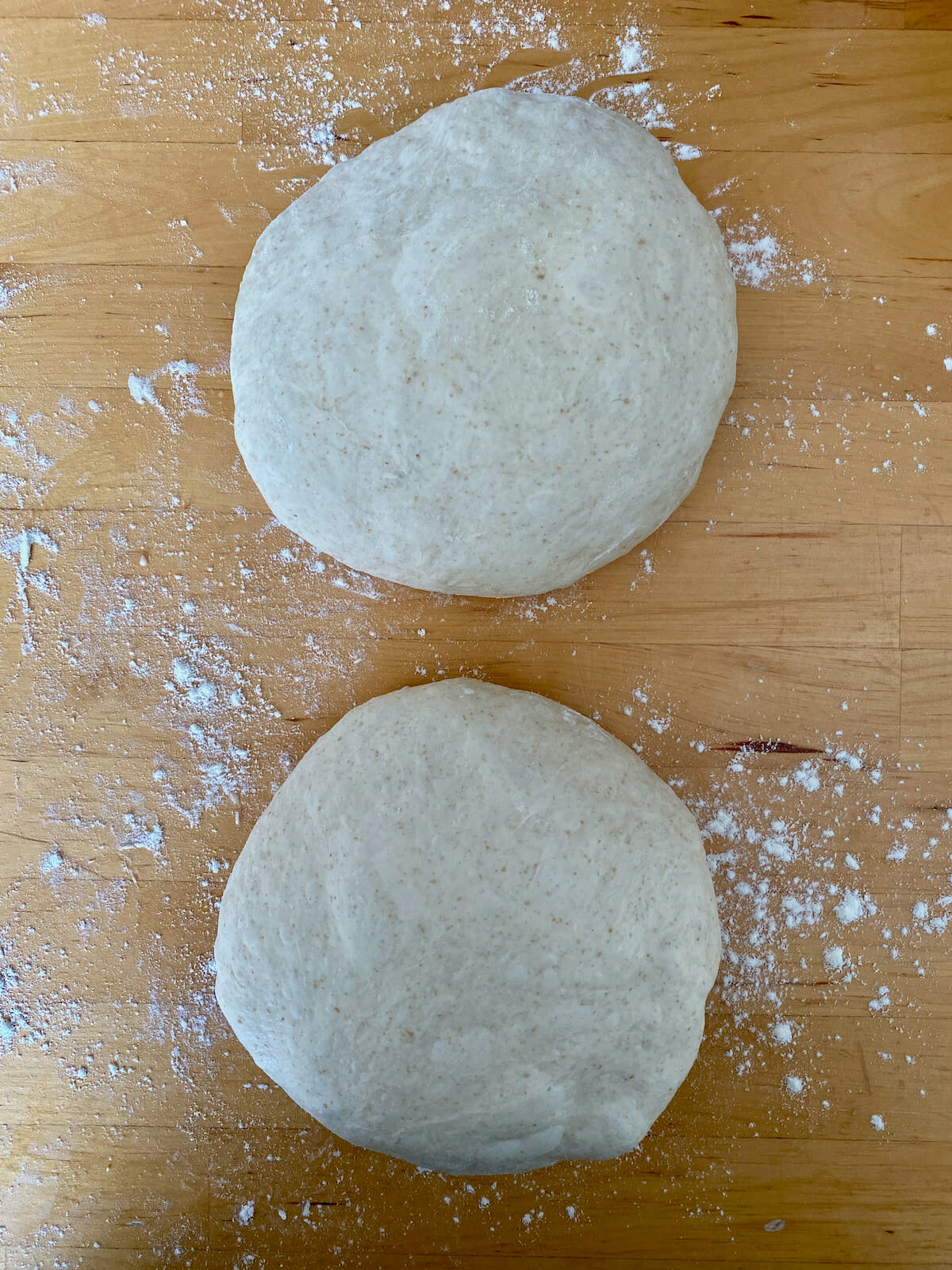
Stretch the Dough
- After proofing, you can use the dough to make pizza immediately. Alternatively, transfer it to the refrigerator for up to 4 days for a more tangy flavor or freeze it for up to 3 months.
- To stretch the dough, take one of the proofed dough balls and place it on a lightly floured surface or a piece of parchment paper.
- Gently press down about an inch from the edge dough with your fingertips to create a crust, working your way around the dough, to start stretching it into a round shape.
- Continue to stretch the dough by gently pressing and pulling the edges outward, rotating the dough as needed, until you've reached your desired size and thickness for the pizza crust.
- If the dough starts to resist stretching or springs back, let it rest for a few minutes and then continue stretching.
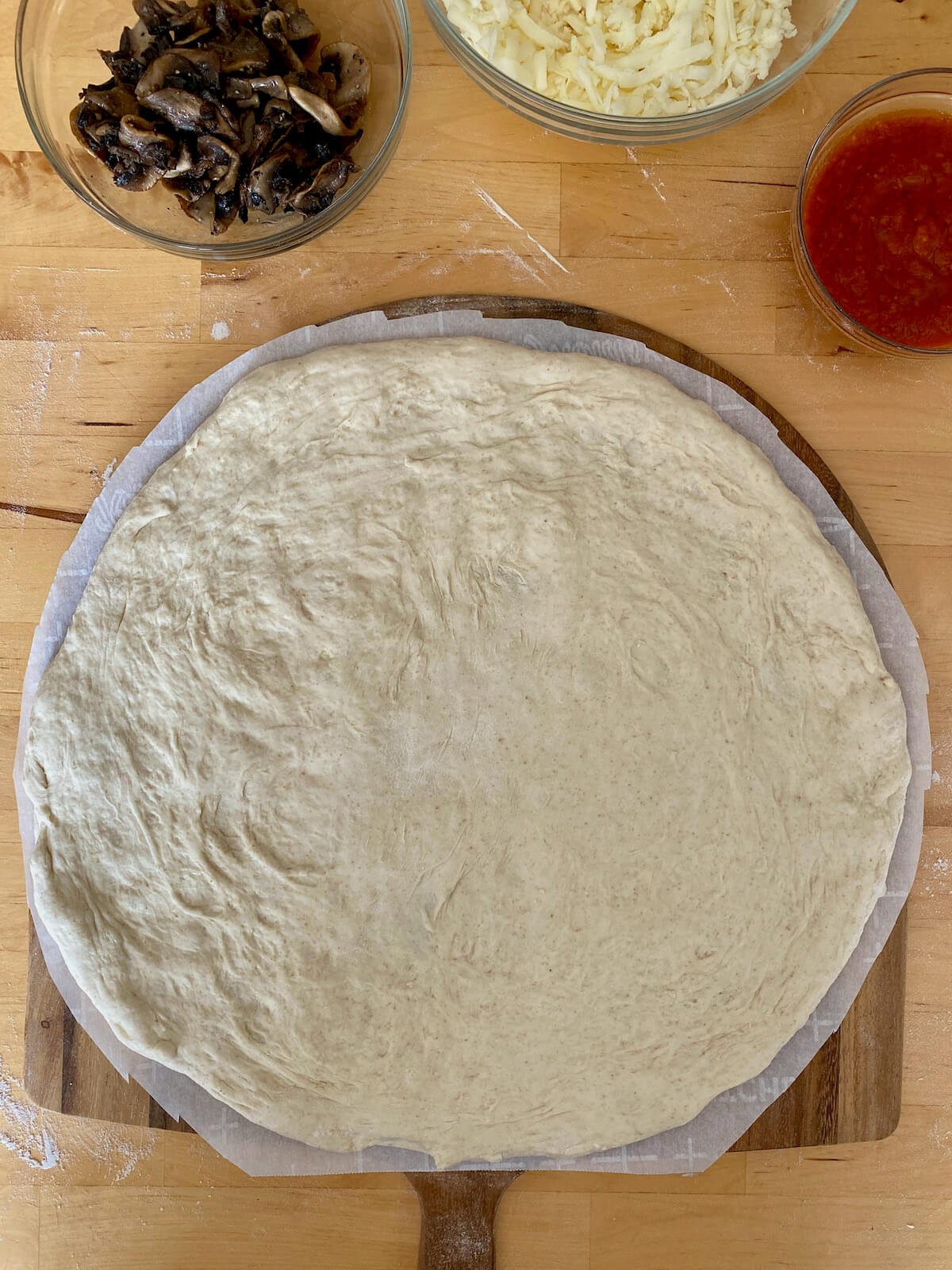
Timeline for Making Same Day Sourdough Pizza Dough
If you're craving homemade pizza but forgot to plan ahead, this same day sourdough discard pizza dough recipe has you covered. Starting at noon, follow this timeline to have delicious, tangy pizza ready for dinner.
- 12:00 PM: Mix the dough and let it rest for 20 minutes.
- 12:20 PM: Perform the first set of stretch and folds.
- 12:35-1:05 PM: Perform three additional sets of stretch and folds every 15 minutes.
- 1:05-1:35 PM: Perform additional stretch and folds if needed until the dough appears smooth and feels elastic.
- 1:35-3:35 PM: Cover the dough and let it rise in a warm environment for about 2 hours.
- 3:35-3:50 PM: Divide the dough into 2 equal pieces and shape each piece into a ball.
- 3:50-4:10 PM: Cover the dough balls and let them rest for 15-20 minutes.
- 4:10-4:30 PM: Stretch each dough ball into a pizza crust.
- 4:30-5:00 PM: Add pizza toppings, bake, and enjoy!
Please note that this timeline is a general guide and may vary based on the temperature of your kitchen and the strength and age of your sourdough starter. Adjust the timeline as needed to fit your schedule.
How to Cook Sourdough Pizza Crust
This recipe focuses solely on creating a flavorful sourdough pizza dough, not the entire pizza itself. It provides the perfect blank canvas for any pizza recipe and cooking method you prefer.
My personal favorite method is baking it in a 550°F oven on a preheated pizza stone for 8-10 minutes. Alternatively, you can grill it, use a baking sheet or cast iron skillet, or cook it in a pizza oven.
For more cooking suggestions, refer to the recipe card notes.
Topping Ideas
When it comes to pizza toppings, the possibilities are endless. Don’t be afraid to get creative and have fun! Here are some delicious pizza topping ideas to try:
- Margherita Pizza- A simple and classic option featuring ripe summer tomatoes and fresh basil.
- Mushroom Pizza- One of my favorite pizza toppings, mushrooms are hearty, filling, and perfect for vegetarians. Pair them with my delicious San Marzano tomato sauce!
- Buffalo Chicken Flatbread- Diced buffalo chicken, red onions, and blue cheese or ranch dressing create a flavorful combination.
- Bolognese Pizza- Use leftover bolognese sauce for a rich and satisfying pizza.
- Parmesan Garlic Pizza- Creamy parmesan garlic sauce replaces traditional pizza sauce for a tasty white pizza.
- Pesto Chicken- Pesto sauce, grilled chicken, cherry tomatoes, and fresh mozzarella make a bold and satisfying pizza.
- Taco Pizza- Seasoned ground beef or turkey, salsa, diced tomatoes, shredded lettuce, and cheddar cheese provide a tasty twist.
- Breakfast Pizza- Perfect for breakfast lovers, make a pizza with scrambled eggs, bacon or sausage, cheddar cheese, and sliced tomatoes.
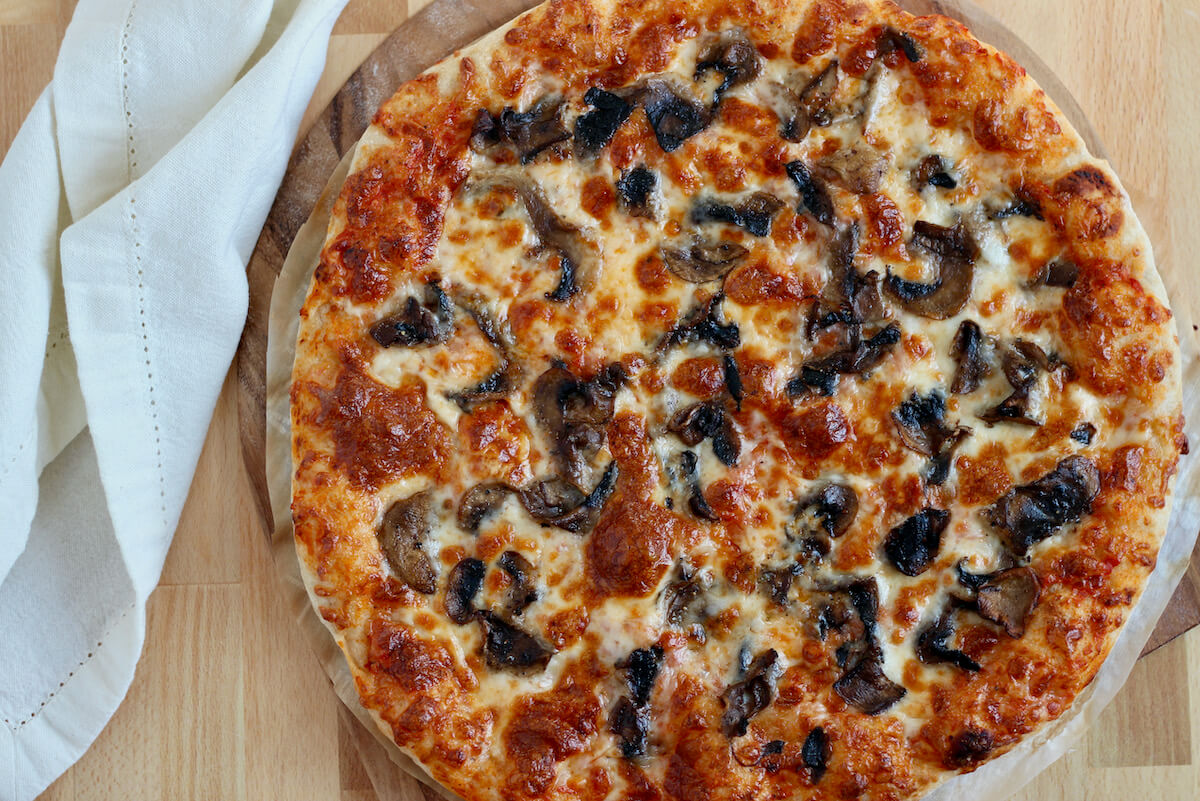
Can You Put Sourdough Discard Pizza Dough in the Fridge?
Would you believe that this sourdough pizza dough recipe gets even better after a few days in the fridge? That’s right! The longer it’s stored in the refrigerator, the stronger the sourdough flavor will be.
Storing the dough in the refrigerator also means you can prepare it ahead of time for a quick and easy pizza night whenever you want. You can store this dough in the refrigerator for up to 4 days so, you’ll never need to order pizza again!
To refrigerate sourdough pizza dough, simply place it in an airtight container or tightly wrap it in plastic wrap to prevent it from drying out. When you're ready to use it, remove the dough from the fridge, let it warm up for about 30 minutes, then proceed with shaping and baking as usual.
Can You Freeze Sourdough Pizza Dough?
Absolutely! Freezing sourdough pizza dough is a fantastic way to extend its shelf life and have homemade sourdough pizza dough on hand whenever you need it. Simply follow these steps:
- After shaping the dough into balls, place them on a baking sheet lined with parchment paper and freeze until solid.
- Once frozen, transfer the dough balls to a resealable freezer bag or airtight container and store for up to 3 months.
- When you're ready to use the dough, remove it from the freezer and let it thaw in the refrigerator overnight.
- After thawing, let the dough warm up on the counter for about 30 minutes before shaping and baking as usual.
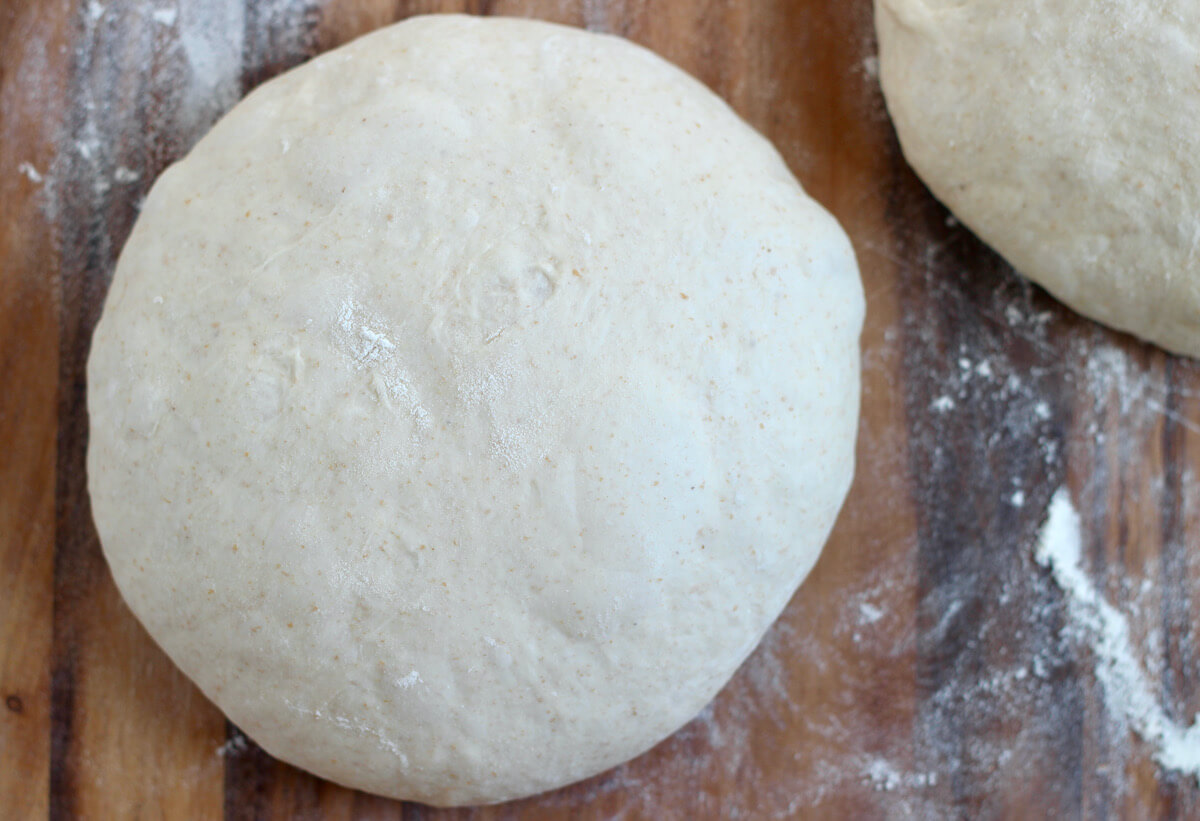
Frequently Asked Questions
Absolutely! Sourdough starter creates a delicious pizza crust with better texture and flavor compared to commercial yeast.
Sourdough discard is best used within 1-2 weeks, but it can still be used after this time. After a couple of weeks, you may notice a gray liquid called hooch on top, which is safe to eat and indicates the yeast is running low on food.
If your dough is sticky, don't worry! This is a higher hydration dough that is meant to be on the sticky side. You can use extra flour when shaping and stretching the dough. Also, consider using cornmeal, semolina flour, or parchment paper when transferring the dough to the baking surface. These methods will help prevent sticking and make handling the dough easier.
If your dough is tearing when you stretch it, it may be too cold or not rested enough, or it may not have developed enough gluten during the stretching and folding process. Allow it to come to room temperature and rest for a few minutes before trying again. You can also pinch small holes together to patch them.
Your dough may not be rising if your kitchen is too cool, your discard is old, or your starter is still young. Ensure a warm environment for fermentation, use fresh discard, and give your starter time to mature for optimal rising.
Yes, you can make this recipe in a stand mixer using a dough hook. Knead the dough for about 5-7 minutes or until it's smooth and elastic and passes the windowpane test.
Leftover pizza dough can be transformed into various dishes such as breadsticks, calzones (like my eggplant parm calzone), focaccia, or even cinnamon rolls. Get creative and experiment with different recipes to make the most of your dough.
Let's Connect!
Be sure to leave a comment below if you have any questions. You can also connect with me on Instagram, Facebook, Pinterest, or via email at [email protected].
📖 Recipe
Sourdough Discard Pizza Dough
Ingredients
- 4 ⅛ cups (500 grams) bread flour
- 1 ¾ cups (400 grams) sourdough starter discard
- 1 ¼ cups (300 grams) warm water 80-90°F
- 1 ¾ teaspoons (10 grams) kosher salt
Instructions
- Mix Dough: In a large mixing bowl, combine the bread flour, warm water, sourdough starter discard, and kosher salt. Mix everything together until no dry flour remains and a cohesive dough forms. Cover the bowl and let the dough rest for 20 minutes.4 ⅛ cups (500 grams) bread flour, 1 ¾ cups (400 grams) sourdough starter discard, 1 ¼ cups (300 grams) warm water, 1 ¾ teaspoons (10 grams) kosher salt
- Stretch & Folds: After 20 minutes, lightly wet your hands with water. Gently stretch one edge of the dough up and fold it over onto itself. Rotate the bowl 90 degrees and repeat, stretching and folding the dough a total of four times. After the fourth fold, flip the dough over so that the seam side is facing down. Cover the bowl again and let the dough rest for 15 minutes. Repeat the stretching and folding process for a total of 4-6 sets or until the dough appears smooth and feels elastic.
- Bulk Fermentation: Cover the dough and allow it to rise in a warm environment (70-75°F, 21-24°C) for about 2 hours. Note that it may take more or less time to rise depending on factors such as the warmth of your kitchen, the activity level of your sourdough starter, and the age of your discard. The dough should double in size and have noticeable gas bubbles forming on the surface. If your kitchen is cooler, consider placing the covered bowl inside an off oven with just the light on to provide gentle warmth.
- Divide & Shape: Carefully turn the dough out onto a lightly floured work surface. Using a bench scraper, divide the dough into 2 equal pieces. Shape each piece by gently pulling the dough into a rough rectangle. Then, fold the top edge of the rectangle down towards the center, pressing lightly to seal. Repeat this process with the bottom edge, folding it up towards the center and pressing lightly to seal. Next, fold the left and right sides of the rectangle towards the center, overlapping slightly, and press lightly to seal. Finally, flip the dough over so that the seam side is facing down, and use your hands to gently shape it into a smooth, round ball.
- Proof: Place the dough balls on a lightly floured surface or parchment paper and cover them with plastic wrap. Let them rest at room temperature for 15-20 minutes before using them for pizza.
- Stretch: After proofing, you can use the dough to make pizza immediately. Alternatively, transfer it to the refrigerator for up to 4 days for a more tangy flavor or freeze it for up to 3 months. To stretch the dough, take one of the proofed dough balls and place it on a lightly floured surface or a piece of parchment paper. Gently press down about an inch from the edge dough with your fingertips to create a crust, working your way around the dough, to start stretching it into a round shape. Continue to stretch the dough by gently pressing and pulling the edges outward, rotating the dough as needed, until you've reached your desired size and thickness for the pizza crust. If the dough starts to resist stretching or springs back, let it rest for a few minutes and then continue stretching.
Video
Notes
- Measure ingredients by weight. For the most accurate and consistent results, measure your ingredients by weight using a food scale. If using measuring cups for flour, spoon it into the cup rather than scooping it from the container.
- Use enough flour while stretching. To prevent the dough from sticking to your hands or the work surface while stretching, dust lightly with flour as needed. This will make it easier to handle and shape the dough without tearing or sticking.
- Storage: Store dough in an airtight container for up to 4 days in the refrigerator or 3 months in the freezer.
- Make Ahead: The dough develops more flavor the longer it sits in the refrigerator and can be made up to 4 days ahead.
- Suggested Cooking Methods:
- Pizza Stone in the Oven- Preheat the oven with a pizza stone inside to 550°F. Build pizza on a pizza peel, then transfer the pizza directly to the hot pizza stone in the oven. Cook pizza for approximately 8-10 minutes.
- Sheet Pan in the Oven- Preheat oven to 500°F. Build pizza on the sheet pan, then transfer the baking sheet to the preheated oven. Bake pizza for 15 minutes.
- Grill Pan on the Grill- Preheat grill to 500°F. Build pizza on a grill pan, then transfer the grill pan to the preheated grill. Turn down the middle burner to medium-low to prevent the bottom of the pizza from burning. Close the grill lid and cook for 8-10 minutes.


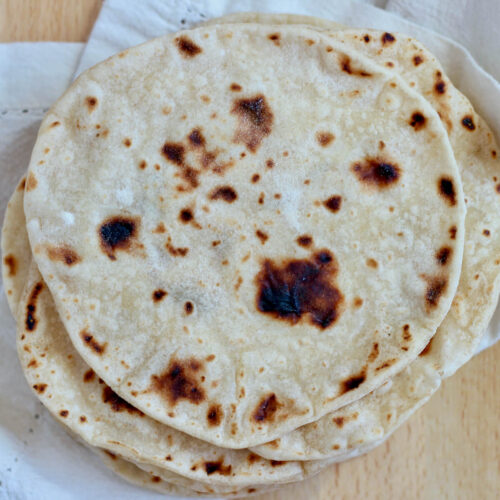
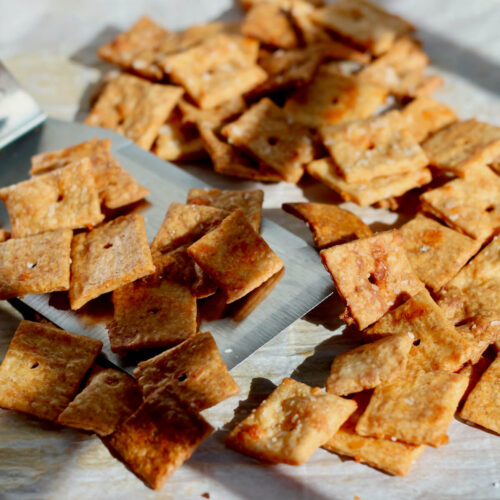
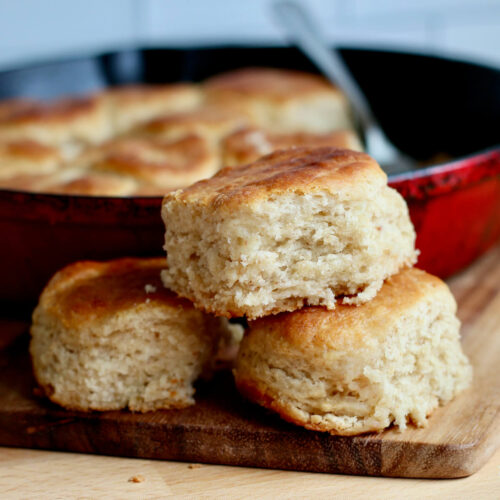

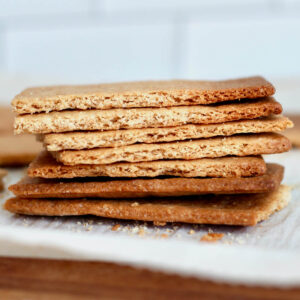

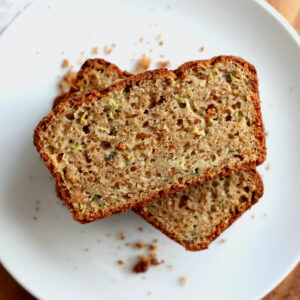

Heather says
I'm just trying out this recipe but I have never made sourdough pizza crust that does not call for oil?
Ashley Petrie, RDN, LDN says
Hi Heather! I've never added oil to my sourdough pizza dough, and I love the way it turns out every time. However, I have made other pizza dough recipes that do call for oil and they also turn out great. Feel free to add a tablespoon or two of oil to your dough, if you prefer! You can also coat the bowl in oil while the dough rises. Hope that helps and that you enjoy your pizza! Ashley 🙂
Anne says
Love the recipe. How long (roughly) to thaw from frozen before use?
Ashley Petrie, RDN, LDN says
Hi Anne! Thank you so much. I would say it takes about 12 hours to thaw the dough in the refrigerator or about 2-3 hours on the counter. I hope this helps! 🙂
Briana says
Love this recipe! What temperature do you cook yours on? 400°? I've made this twice before but can never remember the temp and don't see it listed above! Thank you in advance
Ashley Petrie, RDN, LDN says
Hi Briana! Thank you so much, I'm so glad you love the recipe! 🙂
I cook my pizza at either 550°F in the oven on a pizza stone or around 450-500°F on a grill pan on the grill (when it's too hot to cook in the summer). Both of these methods cook the pizza in about 8-10 minutes. I've also used this dough on a baking sheet in the oven at around 450°F and in a cast iron skillet to make pan pizza. When it comes to pizza, the hotter the better. The trick is to cook the crust quickly so that it doesn't become soggy from the toppings. I hope this helps! Let me know if you have any more questions 🙂
Briana says
Oh my gosh, THANK YOU!! I was definitely struggling with the soggy part! Appreciate your reply 🫶
Ashley Petrie, RDN, LDN says
Of course! Good luck in your future pizza endeavors! Let me know if you ever have any other questions 🙂
Chelsea says
Hi when using cast iron skillet do you put that in the oven? At 450? I do not have a pizza stone... need to order one...
Ashley Petrie, RDN, LDN says
Hi Chelsea! I would recommend preheating the cast iron skillet either in the oven at 500°F or on the stovetop before putting the dough in. Once hot, you can build your pizza inside of the skillet, then bake until the cheese is golden-brown and bubbling. Hope this helps!
kristina says
How old of sourdough discard can you use.
Ashley Petrie, RDN, LDN says
Hi Kristina! If the discard has been stored in the refrigerator, it can easily last for up to 2 weeks or longer. I've used month-old discard without issue. Hope this helps! Ashley
Whitney says
I’m new to sourdough and learning along the way. My dough is very sticky and tears when I stretch it. Any suggestions of what happened and what to change for next time? Thank you!
Ashley Petrie, RDN, LDN says
Hi Whitney,
This pizza dough is on the higher side for hydration and is meant to be a bit sticky. It gives it a wonderful texture but can be challenging to work with if you’re newer to sourdough.
I’d recommend being generous with the flour when you’re stretching it out for pizza so it doesn’t stick to your hands or the counter.
As for the tearing, make sure you’re building a strong gluten structure during the “stretching and folding” stage - if you haven’t noticed a significant change in how the dough feels after 4 sets, you can do a few more. You can also try the windowpane test to see if you’ve built enough gluten structure in the dough.
Another tip is to take your time stretching out the dough for pizza, giving it a few minutes to relax if it feels like it’s resisting.
I like shaping the dough into a round by using my fingertips to create the crust. Then, I’ll gently pull around the edges to stretch it evenly, paying attention to areas where the dough is thicker. I find this helps me evenly stretch the dough out and avoid creating any thin spots that might tear.
I hope this helps!
Ashley
Keely says
Do you have to let the dough come to room temperature after you take it out of the refrigerator? Or can you just use it right away even though it’s cold?
Ashley Petrie, RDN, LDN says
Hi Keely! It's a little easier to stretch out if you let it warm up a bit, but I usually just use it straight from the fridge. Hope this helps! 🙂
Lindsay says
When would u add in herbs or garlic to the dough?
Ashley Petrie, RDN, LDN says
Hi Lindsay! You definitely can add herbs and garlic if you'd like! I'd start with 1-2 teaspoons of dried Italian seasoning and 1-2 cloves of finely minced garlic and adjust from there. Hope this helps! 🙂
Melissa says
Can I make this without salt? My husband has to eat low salt.
Ashley Petrie, RDN, LDN says
Hi Melissa! It will still act like pizza dough without salt, but the flavor will be different. You can try it and see how you like it! If it's too bland, maybe try adding some garlic powder and herbs to give it a little more flavor. Hope this helps! Ashley
Jillian says
Hi! I measured by grams and 400g of discard seems like SO much and I needed to add a little extra flour but my dough is still SUPER sticky. Is that normal?!
Ashley Petrie, RDN, LDN says
Hi Jillian! Yes, it's normal. It's a wet dough so building a strong gluten structure using the stretch and fold method is important to make it easier to work with (but it can still be challenging). Building tension while shaping it into dough balls also helps. It's okay to add some flour if that makes it easier for you to work with. I usually don't add any additional flour until I'm stretching it out, then I generously flour the dough and my work surface so it doesn't stick. Hope this helps!
Jillian Gurrola says
Is it alright to bulk ferment overnight if the rise doesn’t happen in the 2 hours per the instructions?
Ashley Petrie, RDN, LDN says
Yes, you can leave it overnight to rise.
Christian says
My starter isn’t 100% hydration will it still work?
Ashley Petrie, RDN, LDN says
Hi Christian! You would have to adjust the amount of water in the recipe to match the difference in your starter.
Makayla streeter says
My family absolutely loves this pizza dough!! Is the calorie count 1,264 for the entire batch? Or is it 1,264 per dough, making the entire batch 2,528? Thank you!!
Ashley Petrie, RDN, LDN says
Hi Makayla! I'm so happy to hear you and your family love this recipe!! 🙂 Yes, the calorie count is approximately 1,264 for one dough or 2,528 for the entire batch. Hope this helps!
Jacque Entzminger says
Perfect the first try! Great helpful instructions. Thanks so much.
Ashley Petrie, RDN, LDN says
Hi Jacque! I'm so happy it turned out well for you 🙂
Lauren says
Hey there! I always get a little confused with the stretching & folds part.
So would it look something like this?
1st set after the 20 min: stretch fold, rotate bowl stretch fold. Wait 15 min.
2nd stretch fold repeat wait 15min
3rd stretch fold repeat wait 15min
4th stretch fold repeat move on to bulk ferment.
Is that right when you are saying to do 4sets?
Ashley Petrie, RDN, LDN says
Hi Lauren! So each "set" of stretch and folds involves 4 folds, which then is repeated 4 times every 15 minutes (16 folds total over an hour or so). I can totally see how that can be confusing. Try to think of the dough in the bowl as a square - you want to pull all 4 sides of the square up and towards the center, wait 15 minutes, then repeat x4. I hope that helps! If it's still confusing, let me know and I can try to help some more!
Ashley
Jamie says
Can I use AP flour in place of the bread flour?
Ashley Petrie, RDN, LDN says
Hi Jamie! Yes, you can use all-purpose flour. The crust might not be as chewy, but it should still work well!
Charisma Horton says
this was a great recipe. Of course we are all always looking for great discard recipes. But I am also always looking for a great recipe to use in my outdoor pizza oven. It's been a learning curve to figure out all of the ins & outs of pizza dough. The outdoor ovens get hot so fast and I had found a great dough to use for Neapolitan style pizza but it takes 3 days to get the good results. I wanted to try this same day dough and see if I could use it in my pizza oven. It came out delicious. I had the stone at about 500-600 degrees and it cooked up in 5-6 minutes and it was cooked all the way through. A little crisp on the bottom which was perfect. I will also say that this recipe yielded 3 good size pizzas for us. I did let it rise a little longer because I keep our house a little colder. Thank you for sharing your process with us. I am thankful! I will make some dough balls and freeze them to keep on hand now that I know they will work for our system.:)
Ashley Petrie, RDN, LDN says
Hi Charisma! There is so much to making pizza at home and so many different ways to do it! It's a lot of fun to learn about. I'm so happy this pizza dough worked well for you - I also cook mine on my pizza stone and love it! Thank you so much for sharing and for your kind words, I appreciate it! - Ashley 🙂
Dana says
My dough is very liquidy, to the point where I had to add flour. I was being lazy and let the dough knead in my bread machine, so maybe I over mixed it? I hoping it turns out, but if anyone has some tips for next time that would be great!
Ashley Petrie, RDN, LDN says
Hi Dana! I'm not sure what happened as I've never used a bread machine with this recipe. It is a wetter dough, but shouldn't be liquid - could possibly be over-kneaded. Sorry I can't be more help with this! - Ashley
Mary says
Thank you so much for sharing this recipe! We love it! I’m making it again and this time freezing the other dough. Really excited for that. We will let you know how it goes.
Ashley Petrie, RDN, LDN says
Hi Mary! I'm so glad you enjoyed it! I love freezing the extra dough for an easy dinner another day. Thanks for sharing 🙂
Mary E says
Update on the frozen dough. It was just as good!! I was so nervous. We did end up leaving it out a little longer because it would expand and shrink, but once it warmed to room temp the dough was as good as the day we made it!
Ashley Petrie, RDN, LDN says
Hi Mary! I'm so happy that freezing the dough worked well for you. Thanks so much for sharing 🙂
Carly says
Very yummy! Nice chew.
Ashley Petrie, RDN, LDN says
Hi Carly! So glad you enjoyed 🙂
Jasmin says
This was perfection. Thank you for this recipe.
Ashley Petrie, RDN, LDN says
Hi Jasmin! I'm so glad you enjoyed it - thank you for sharing! 🙂
Ashley says
Beat pizza I have ever made! I wanted to make personal pizzas and I was able to make 4 with thus recipe.
Ashley Petrie, RDN, LDN says
Hi Ashley - so happy you enjoyed it! 🙂
Shelley says
Hello,
Do you refrigerate after bulk fermentation or do I go ahead and make them into balls and refrigerate? I’m making it right now. Very excited about this recipe.
Thank you
Shelley
Ashley Petrie, RDN, LDN says
Hi Shelley! You can shape them right after bulk fermentation. Then, you can either refrigerate them or use them immediately, depending on how much sourdough flavor you want there to be. Hope this helps! 🙂
Lucy Gammenthaler says
Hi! What do you use to store your pizza dough in?!
Ashley Petrie, RDN, LDN says
Hi Lucy! I usually store the dough balls in a freezer-safe, gallon-sized storage bag. They will usually flatten out a little bit, but can easily be reshaped and formed into a pizza crust. Hope this helps!
Christy Sowders says
I made this for dinner tonight and it was very good. Started at noon and we were eating by 5:30pm. The dough is very sticky, I have only worked with lower hydration doughs, but was able to figure it out. Instead of splitting the dough, I used my 15 inch stoneware bar pan and made one deep dish pizza. I was a little worried that the dough would not bake all the way through since it was much thicker than the recipe planned for. I let it bake about 15 minutes and it was great. The bottom was nice and brown. Nice puffy edges and was strong enough to be able to hold a large piece without flopping over. Thank you so much!
Ashley Petrie, RDN, LDN says
Hi Christy! Deep dish pizza sounds delicious - thank you so much for sharing! I'm glad it worked well for you and that you enjoyed it 🙂
Jillian says
I made this exactly as written. Put one ball in an oiled bowl in the fridge for two days before using. Took out an hour or two before to let it come to room temp. Easily stretched to my pan.
Put the other in an oiled bag and put in the freezer.
This baked up beautifully. I put in an approx 425-450 oven for 10-12 min.
Ashley Petrie, RDN, LDN says
Hi Jillian! So glad you enjoyed 🙂
Jenna says
So is there no pre-bake needed for the crust?
Ashley Petrie, RDN, LDN says
Hi Jenna! You can pre-bake the crust if you prefer, but I never do. This is a recipe for pizza dough, not any specific type of pizza, so you can use it however you'd like!